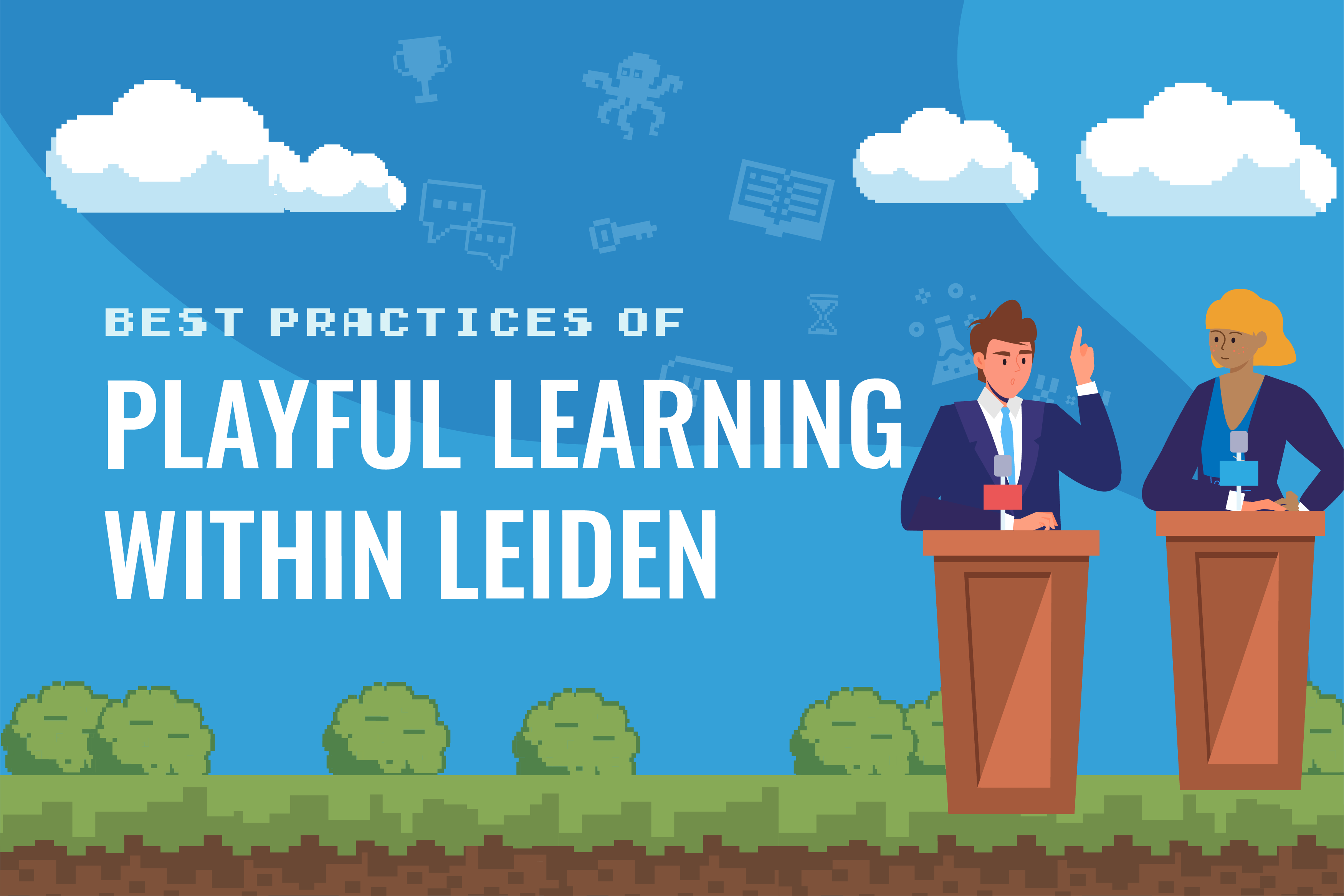Insights
Best Practices of Playful Learning at Leiden University
In our previous article, we defined playful learning and looked at what it can bring to education. There is already a lot happening with playful learning and similar topics in education. In this article, we outline some examples of playful learning and serious gaming that are already happening at Leiden University.
Introduction
There are several pedagogical reasons to apply playful learning in higher education. To name a few:
- It provides learners a safe space where they have the freedom to fail. Their failure does not have serious consequences in the real world and it is seen as a necessary part of the learning process. This can help learners build resilience to failure and take measured risks, which can lead to a greater ability to innovate.
- It enables learners to immerse themselves in the “spirit of play”. They accept the alternate rules and goals of the play, and can set their imagination free, which can lead to greater creativity.
- It stimulates the intrinsic motivation of learners to engage with learning activities. It’s their own choice to participate, which is motivated by the internal benefits of play. This intrinsic motivation can lead to personal exploration, experimentation, and discovery.
In order to put the research to the test, we interviewed several teachers and staff members from Leiden University to ask them about their experiences with applying playful learning in their teaching.
Best Practices
Brave New World Conference – Daniek Bosch & Tanja de Bie
What
The Centre for Innovation hosted a two-day game at the Brave New World Conference (2018) and LXDCON (2019) that was played during the breaks. During this game, all attendees of the conference experienced what would happen if countries could make their own policy choices without having to take into account the consequences for the rest of the world. The attendees were divided among different tables. Every table represented a different country that could make their own decisions and spend their money on multiple topics, resulting in different possible scenarios. Examples of resulting scenarios include uploading everyone’s mind to continue living digitally forever, leaving the planet or saving the planet.
Why
Once the attendees empathized more with the game environment, they realized that it was representative of the real world. By forcing people to participate in something different in a playful way, they gained insights into the bigger picture. In playing this game, participants were able to explore and discover the impact of their choices, think outside the box, and come up with more creative solutions.
Moot Court – Esther Kentin
What
Leiden Law School started with the compulsory Bachelor course ‘Moot Court’ in 1992. During the Moot Court, students are pretending to act as lawyers and make oral arguments in a simulated courtroom. Working groups of 16 students are divided into subgroups of four. These subgroups have their own skills trainer that teaches the students how to present the case, using tools such as roleplaying and video recording. The course consists of three parts: Three writing assignments, five skills training sessions, and the final oral pleading (the Moot Court final exam). The first assignment is a short memo. The students study a case, determine the applicable law, and develop pro and contra arguments. The second assignment consists of an in-depth legal analysis, in the format of a memorial. The third and final assignment is writing the pleading notes, to be presented at the final exam. During this final exam, the students present their oral argument before a court consisting of faculty members and professionals, such as practicing lawyers and judges. This bench will assess the oral argument, including the answering of questions of the judges, and rebuttal and surrebuttal.
Why
The Moot Court is a simulation of actual legal proceedings. Students enjoy the course because it is practical and hands on. They are required to apply their knowledge of the law on factual situations and make a case before the court. The course demands research, creativity and empathy with the ‘client’ seeking redress. Furthermore, the small-scale subgroup meetings enhance teamwork and contact between the students. Finally, students appreciate the direct contact with the lecturer during individual tutor meetings.
Business Game – Jean-Pierre van der Rest
What
In the minor Social and Business Entrepreneurship at Leiden University, students follow a Business Game course. The students play an online game in groups of three or four, in which they are part of a team in a competitive business environment. The goal of the game is to increase the company value and to become the market leader. They have an output screen with all the relevant information and documentation from the “company” and an input screen where they face a multifold of decision-making challenges. They can buy additional information, but they have a limited amount of money. The first three rounds focus on the calculations necessary to match supply and demand. Rounds four to ten are highly complex as students have to make all the decisions for the company (around 40 decisions). For example: “How much to produce?”, “Do we need more staff?”, and “In what marketing campaign shall we invest?”.
Why
The game is intended as an introduction to the professional field. The game is a simulation of a complex reality and the students have to apply a lot of business theories, such as on strategy and marketing. Since it is a simulation, they have the freedom to fail. By playing this game, the students learn that the decisions they make under conditions of uncertainty have consequences and they learn how leadership, entrepreneurship, strategy, and teamwork are all interrelated.
Practicing conversation techniques – Carlijn Bergwerff
What
In the Leiden University bachelor Pedagogical Sciences, students follow a course to practice their conversation techniques with parents, children, and in multidisciplinary meetings. Before, they used to practice this through roleplay with other students. But in the past two years, students have practiced their conversation techniques by watching interactive 360° videos on their computer. Each video is filmed from the perspective of a pedagogue, who has a conversation with two parents, a young person, and a child. The videos have the following structure: The students see a fragment of a situation, they answer an open question (“How would you react to this?”), they are given three options of how to respond and they choose one, they see a follow-up fragment that matches their response, and at last they get feedback on their chosen response. This academic year, the interactive videos will be supplemented with Virtual Reality (VR) to practice complex conversations.
Why
Student evaluation forms indicate that the sense of competence and self-confidence in conducting conversations has greatly increased after practicing with the interactive 360° videos. The students also find the virtual conversations educational, realistic, and fun to do. They like that they can experiment and see the effects of different choices, receive immediate feedback on their choice, practice the same conversation several times, and practice realistic and complex conversations in a safe environment.
Two-stage examination – Mario de Jonge
What
Testing ensures that information can be remembered and is less likely to be forgotten in the long term. This is called the “testing effect”. Unfortunately, most students don’t see tests as an important part of their learning. One way to make testing more meaningful is to give it a playful twist. For example, by using a two-stage exam. Students first take an individual exam and hand it in. The teacher then immediately divides the students into groups of four and lets them do the exact same exam again. The group has to agree on all the answers. In this way, they teach each other what they got wrong during the individual exam. This can be used for summative assessment, but especially for formative assessment. For example, in some Team Based Learning courses at LUMC, it is used to assess student’s prior knowledge. It can serve as a preparatory exercise, making students more confident to take the real exam.
Why
Research has shown that student retention is better when frequent practice tests are being used. The two-stage exam can be a way to get students to remember information for a longer period of time. It provides learners with a safe environment to learn. If you use this two-stage exam, communicate to your students that you are doing this to create a learning moment.
Conclusion
These are just a few examples of what is already happening at Leiden University. It shows that game-based learning with playful elements can give students or learners practical and hands-on opportunities to collaborate and experiment without being afraid to fail. Motivated by this type of safe space, students and learners are triggered to come up with more creative and innovative solutions to problems and will learn more of the content provided.
Get in touch
Want to know how you can use playful learning in your teaching? Please contact us at c4i@sea.leidenuniv.nl
Not yet convinced of the benefits of playful learning? Read our blog on the definition and theoretical background of playful learning and stay tuned for our next blog on playful learning, where we look deeper into the use of escape rooms in higher education.


Get in touch with the authors

Yentl Croese
Learning Experience Designer
y.croese@sea.leidenuniv.nl
Emma Wiersma
Learning Experience Designer
e.m.wiersma@sea.leidenuniv.nl





